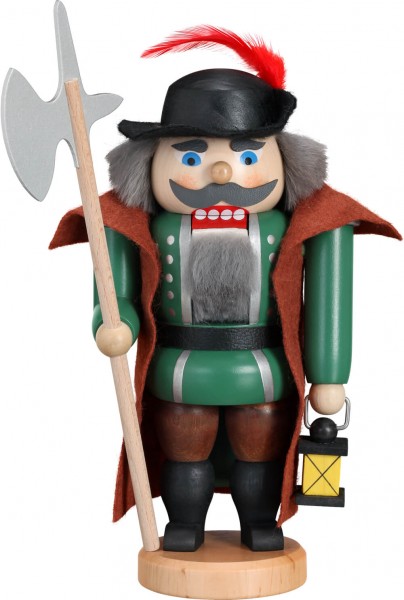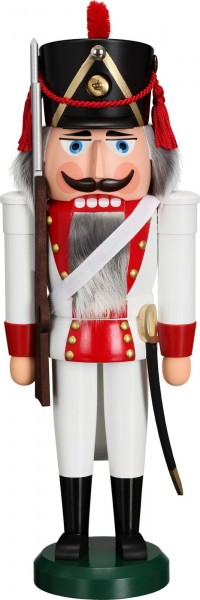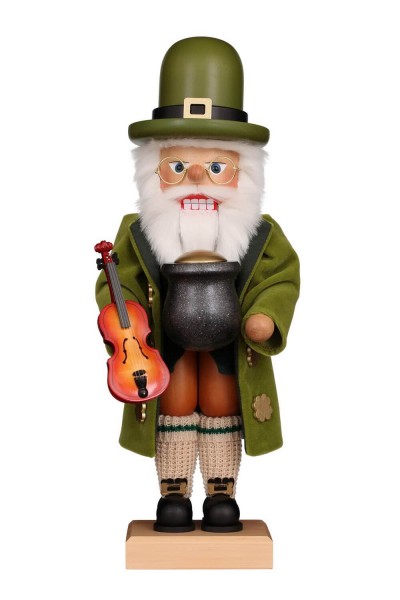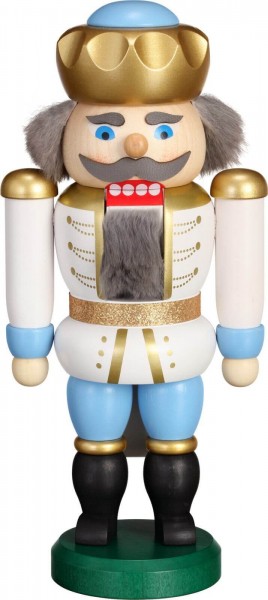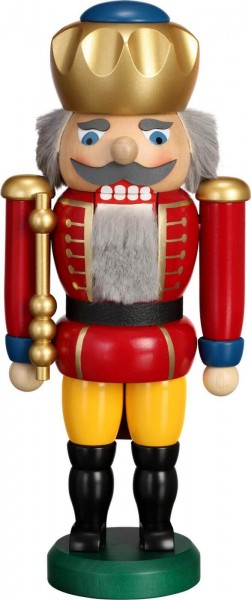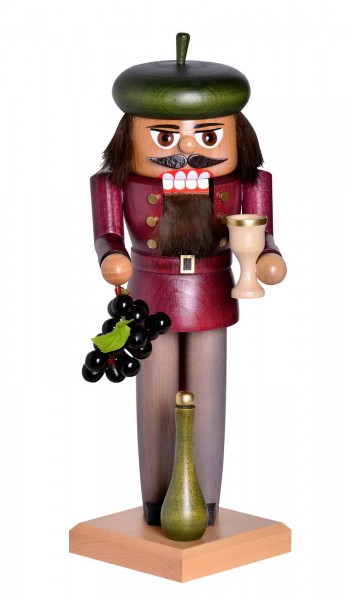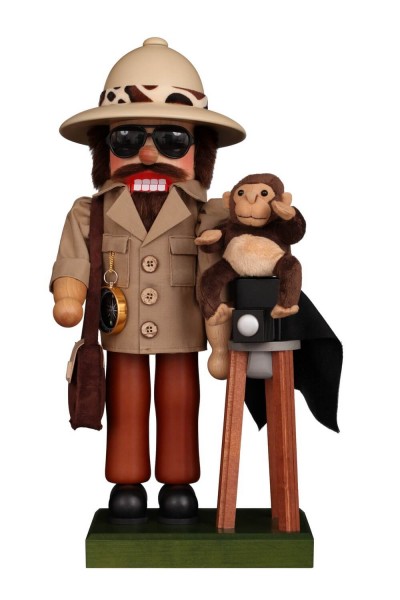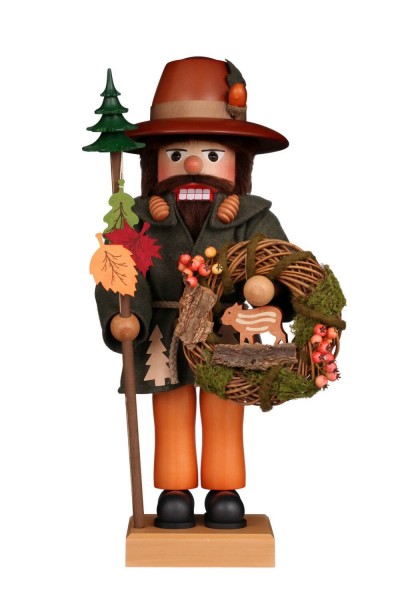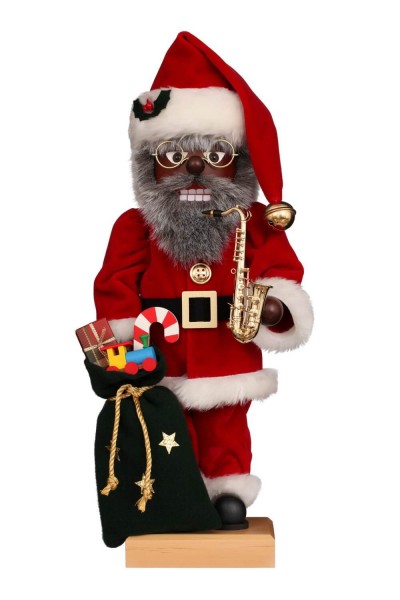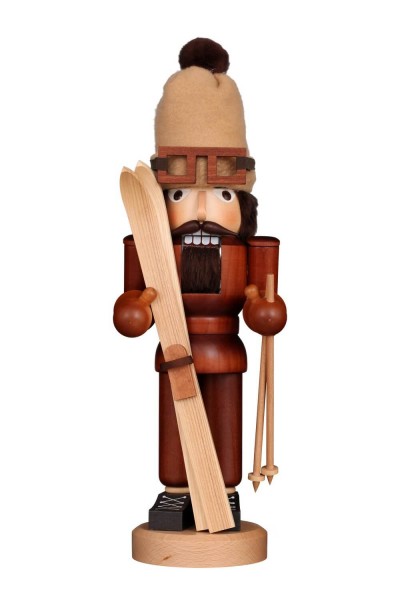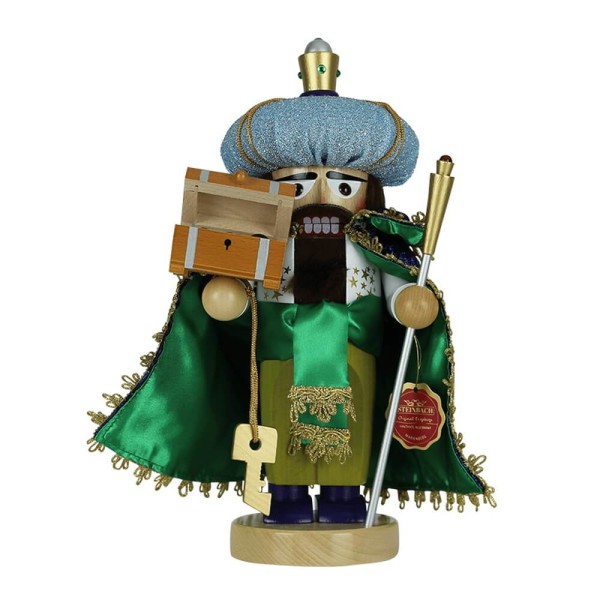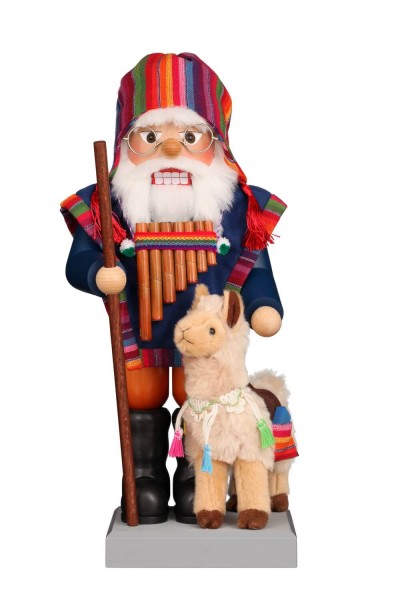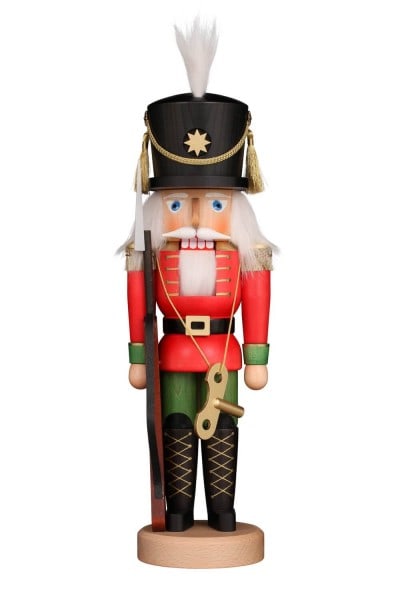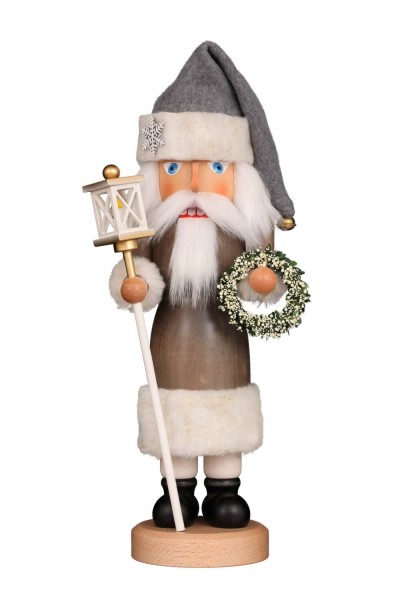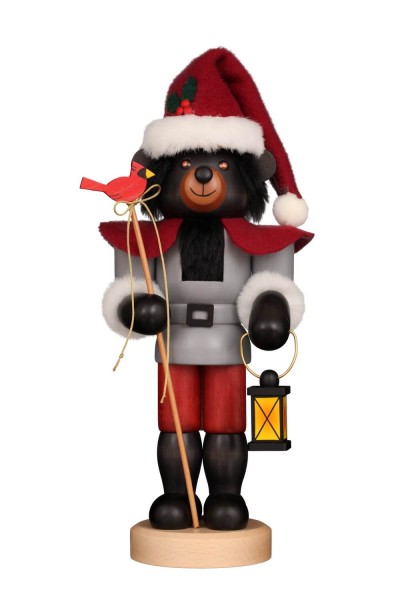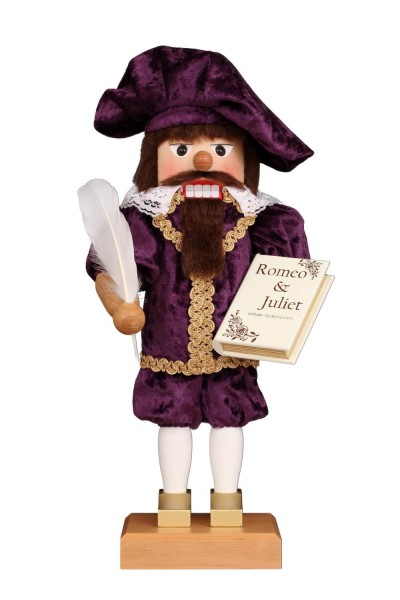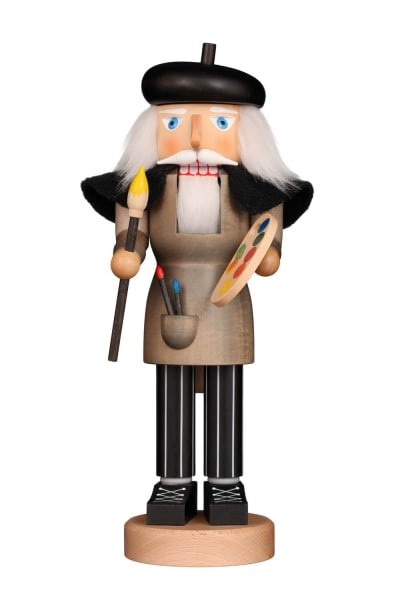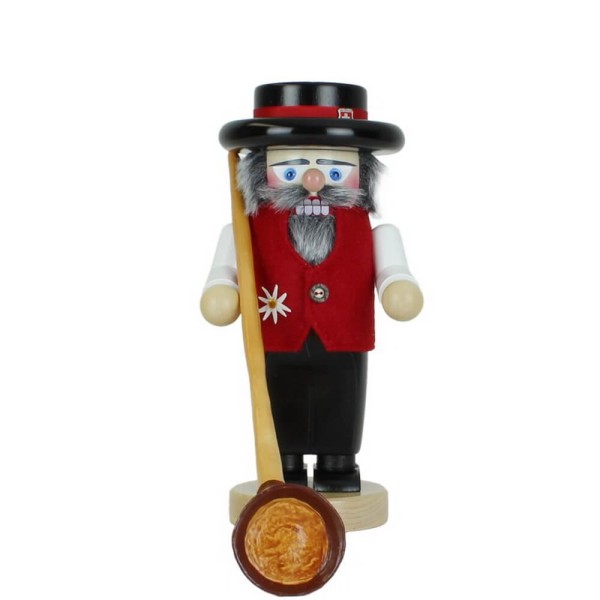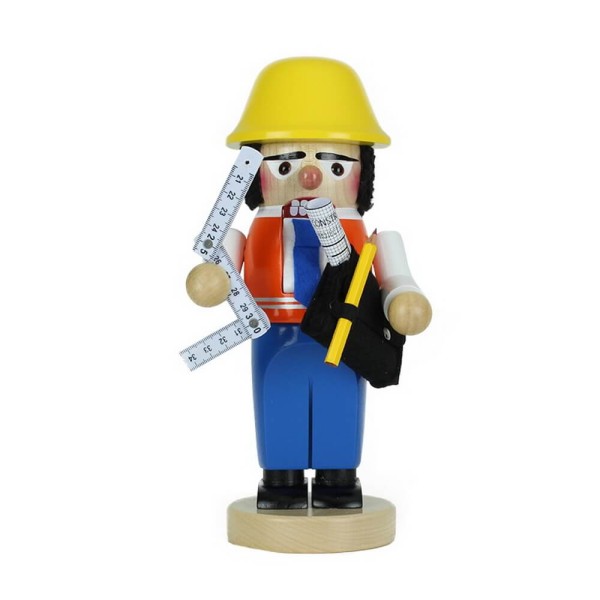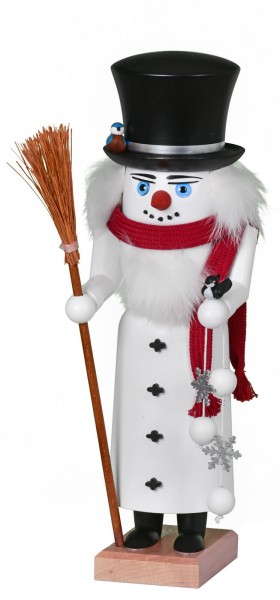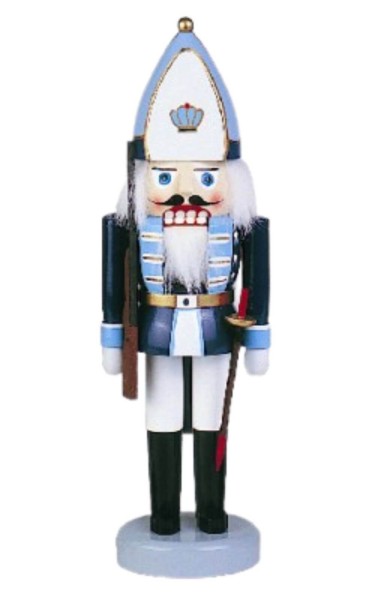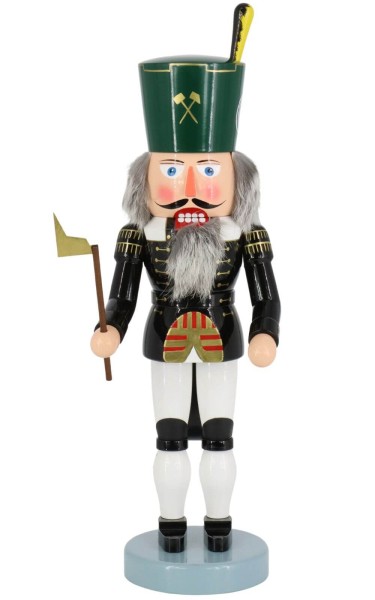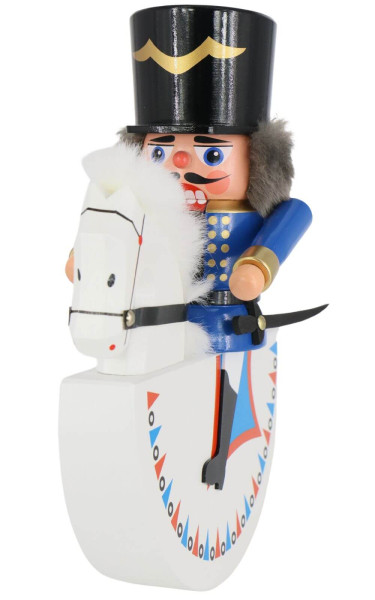nutcracker from the Erzgebirge - Made in Germany - as a representative of the authorities
Nutcrackers from the Erzgebirge are just as much a part of folk craftsmanship as candle archs, pyramids and incense smokers and are probably the best-known figure for most people in connection with Christmas decorations. Colorfully painted and with its often grim facial expression, it resembles the authorities of that time such as that of the king, gendarme or the forester. And they should also feel what hard work feels like by having to crack the tough nuts. Another theory traces this back to the special living conditions of the inhabitants of the Erzgebirge after the closure of the ore mines at this time. Turning and carving became the new livelihood of the miners and their families.
How does a nutcracker work?
Physically, a nutcracker is a one-sided double lever. The lever on the back strengthens the manual force so that the nuts burst in the mouth. Nuts are rather no longer placed in his mouth to split them with the small lever on the back.
the history of the nutcracker from the Erzgebirge
He stands there tightly, the little man made of wood with a big mouth, a long beard and a smooth uniform. The sabre always ready and the face warped to a grim face, the wooden nutcracker watches protectly at Christmas time.
The nutcracker figure, like the incense smoker and the Christmas pyramid, have become indispensable in our living room during the Advent season. The history of the wooden soldier extends far beyond the beginnings of wood art from the Erzgebirge, which is often referred to as the cradle of the traditional nutcracker figure. Find out here where the wooden nutcracker comes from and how it came to the Erzgebirge.
nutcrackers – history and tradition
Probably by accident, the first people discovered that the nut as a fruit is edible and nutritious, but hidden by a hard nutshell. Those who could make fires and build spears soon came up with the idea of breaking up nuts with the help of stones in order to get to their interior. Basically, this simple system of brute force is the birth of the nutcracker. Of course, only as a mere tool without decorative use. Therefore, the path from hitting two stones to carving the wooden nutcracker figure was a long way.
nutcrackers as a pure tool in the Ancient peroid
So, for the invention of the first "real" nutcracker, we have to look from the Stone Age to the Ancient. As a student of Plato, the Greek philosopher Aristotle was concerned not only with philosophy, but also with mathematics and physicists. In addition to numerous, probably much more important findings, the scholar found that the lever principle is also ideally suited to crack the hard shell of the nuts. Not only was he right with that, but the nutcrackers still work according to this principle today.
Even if at this time of the Ancient the majority of the population used tools such as the hammer or even the teeth to crack nuts, the upper class seems to have already enjoyed bronze lever arms as nutcrackers. Grave founds from this period prove that even these lever arms had a decorative use.
Artistic decorations of the nutcracker also existed in the Middle Ages when so-called wooden nut pliers were particularly popular.
first nutcracker figures at the beginning of modern times
In the 16th century, the figurative nutcracker developed from the rather tool-typical nutcracker. It is rumored, i. a., by the German literary and linguistic scholar Jacob Grimm that the nutcracker developed as a wooden figure from the idol figures that were set up in the parlours to keep evil spirits away.
1591 is probably of great importance in the story of the grim looking wood soldier, because from this time comes the first and oldest nutcracker figure, which resembles what we know today as the nutcracker. However, this figure did not represent a soldier, but a mendicant monk, who, along with figures of the authorities, was one of the typical depictions of the time. It is said that even Henry VIII Tudor took a liking to the wooden man and gave his second wife Anne Boleyn a painted nutcracker made of elaborate carving. Whether this was used to crack nuts, may be doubted.
nutcrackers from the Erzgebirge – this is how the figures became firmer part of the folk art from the Erzgebirge
The wooden nutcrackers developed in the 18th century in various places known for their carving, such as in South Tyrol or Thuringia and thus became a commodity. Since wood art had established itself in the Erzgebirge as another source of income in addition to the drying up mining, it did not take long until the nutcracker also found its way here.
nutcracker made of wood – historical development in the Erzgebirge
The first nutcracker from the Erzgebirge was created in 1870 by the German craftsman Friedrich Wilhelm Füchtner from Seiffen and is the model for the traditional nutcracker as we know it today. His character was based on the depiction of the nutcracker in the picture book by Dr. Heinrich Hoffmann, which was published 20 years earlier under the title "König Nussknacker und der arme Reinhold“ (king nutcracker and the poor Reinhold), in which there is a connection between the nutcracker and the Christmas season. The wooden soldier plays the hero who leads a poor and sick boy through his toy world in a dream and gives him a touching surprise the next morning. Since then, nutcrackers from the Erzgebirge have been the most famous figure in connection with Christmas decorations and have gained fame worldwide.
Why is the nutcracker considered a typical Christmas decoration?
The reference to the Christmas season probably also results from the harvest time of the nuts until the end of october and with the storage time of the nuts over the winter.
Last but not least, the famous ballet by Pyotr Tchaikovsky, which was premiered under the name "the Nutcracker" in 1892, contributed to the fame of the lovingly designed wooden figures. The play is based on the well-known fairy tale "Nutcracker and Mouse King" by Ernst Theodor Amadeus Hoffmann. These mentions of the nutcracker in art and literature had a lasting impact on the history of the figure and contributed to its becoming a collector's item.
nutcrackers from the Erzgebirge entwined with legends
There are many stories and narratives that try to explain the path of the nutcracker into the wood art from the Erzgebirge. The most famous story is about a farmer living in the region who had great wealth. As it is so often the case, money had this man's heart made hard, so that he was filled with resentment and stinginess. The wealth made the farmer lonely and at Christmas time he always ate the many nuts he could afford all by himself. One day, the farmer found it tedious to crack the nuts and announced that a reward would be given to the one who gave him a way to break open the hard shell without difficulty. The news quickly spread throughout the village and the inhabitants appeared in large numbers to present the farmer with the supposed solution to his problem, but no idea seemed to please the old man. When he had long since given up hope, the doll carver of the village appeared, who had worked on a small wooden figure for three days. At first the farmer laughed, but when he saw that the little man with his big mouth was able to break open the hard nutshell, he was enthusiastic. From now on, he cracked the nuts only with the wooden man, which he closed into his heart so that it became soft again. As a thank you, the farmer gave the carver a new workshop, in which he produced the most beautiful nutcrackers ever seen.
Why do nutcrackers often come across as soldiers or kings?
The miners in the region of Saxony carved nutcrackers on the model of figures they were familiar with. As a wooden figure with a large mouth, it made sense to choose a person of respect as the embodiment. No wonder, then, that the first nutcrackers from theErzgebirge were modeled after representatives of the upper class such as kings, soldiers, gendarmes or foresters. In addition, the population uses the nutcracker figure to caricature the authorities. The upper class people should be at the service of the people in the form of nut-cracking wooden men, at least during the Christmas season, and do the work of the poor people. The population certainly liked to stuff the mouths of the representatives of the upper class with nuts at the end of the year.
Today, in addition to traditional motifs, nutcracker Christmas figures are produced that reflect current trends and are based on contemporary themes. Particularly popular are depictions of various professional groups and influential people from history and politics.
But there are also regional differences, so Americans love orpulent nutcrackers in bright colors with many details. In the USA, especially the nutcrackers of the company Steinbach from the Erzgebirge are known and popular. The large selection of this traditional company Steinbach from Marienberg can now also be found at Seiffen.com. In addition to the classic nutcrackers, you will also find special unique pieces of nutcrackers, such as Star Wars nutcracker in the form of Darth Vader or the Startrooper. In addition to nutcrackers as collector's items in a limited edition, you also get unusual figures such as the nutcracker with Mickey Mouse ears. The choice is limitless!
And it is far too bad to wake up and set up the nutcrackers only at Christmas.
Where is the best place to buy nutcrackers? Of course in the Erzgebirge!
Nutcrackers have a long tradition and are as much a symbol of the Christmas season as the Christmas angel and the Christmas tree. In our online shop we offer a variety of different nutcrackers in different sizes and designs. Browse our website and get real folk art from the Erzgebirge at home!
traditional wooden nutcrackers at seiffen.com
In our small workshop in Seiffen we have been manufacturing our own products for more than 20 years, which are characterized by high quality and great attention to detail. Whether at Easter or Christmas – with nutcrackers from SEIFFEN.COM you can decorate your home all year round. The decorative nutcrackers today have many different faces, in addition to a classic miner or a drummer, a king, a soldier, nowadays you will also find a frog king. Of course, the most diverse professional groups must not be missing as a template for the nutcracker of today.
In our category "nutcracker" we combine tradition with modernity and leave nothing to be desired. From small to large, we offer everything the nutcracker's heart desires. You are welcome to incorporate your individual ideas and wishes for your own personal nutcracker.
Whether you are still missing a very specific collector's item in your series, you want to make a loved one a special pleasure or you want to beautify your own home with a nutcracker, tell us what you need and we will get to work on the nutcracker.
